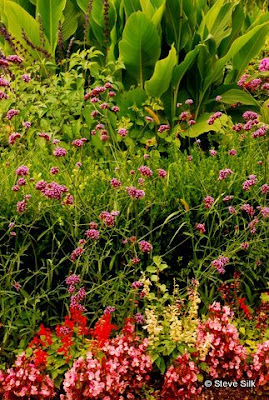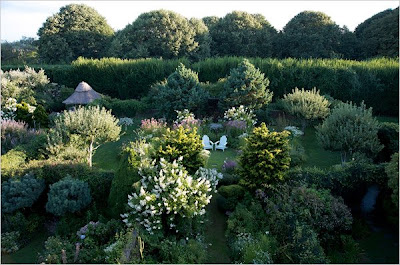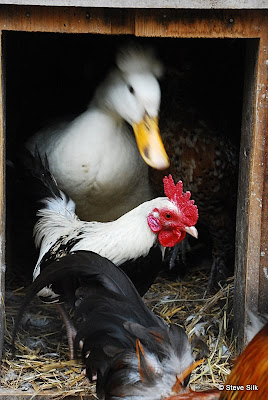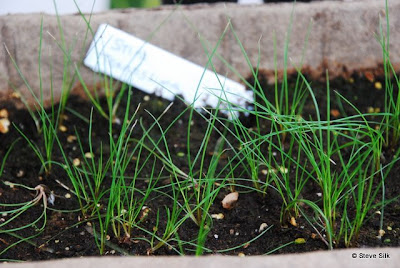I have crossed some very scary, pedestrian-only suspension bridges in the Andes and in Indonesia, but this one? Don't think so. Not even on all fours. Can anyone tell me where in the world this is? I am never, ever going there.
Shout out: Dark Roasted Blend
4.29.2009
4.24.2009
Fab Foliage Friday

Hakonechloa macra 'Aureola'. What a mouthful. And, for sure, an eyeful. Is it possible there is a grass with more graceful form? I don't think so. The gentle, waterfall-like cascade of gold Japanese forest grass is superlative for softening edges, for use in containers, and as contrast with broader-leaved plants...Heck, its use in the garden is virtually limitless. Too bad it's so pricey. But a plant as beauteous as this, with such eye-catching color-I challenge anyone to ignore the sheer splendor of its slender blades of green-streaked sunshine--may well be worth its weight in gold.
For more on the foliage front, check out a story on colorful foliage I did for the local newspaper, the Hartford Courant.
4.22.2009
Moss Man Needs Your Help

Happy Earth Day! Just because Moss Man is looking out for our planet doesn't mean the rest of us can slack off. We all need to do what we can to defend our environment. And happily, gardening is a great way to do that. So, go plant a tree.
Moss Man is the alter ego of Nashville's J. Paul Moore--gardener and photographer extraordinaire--who took this kooky self portrait (and sent it to me after I pleaded for a few shots from his Moss Man series). Enjoy his great garden slide show; on the opening page of his site, click on portfolio, then gardens. While you're at it, his show on architecture features some terrific gardenesque hardscaping and his scenic nature series reminds us of just how beautiful our home planet can be.
4.21.2009
Bob Kamm's Color Craze

 Happy Color brightens the day, even the night. Practitioners of this particular type of gardening are those who've never met a color they didn't like and who aren't shy about proclaiming their passion to the world at large. They have burst free from the shackles of traditional color theory, free, in fact, from almost everything but the pursuit of eye-popping, pysche -searing, no-holds-barred color--and plenty of it. Yippee-Yi-Yo-Ki-Yay!!!
Happy Color brightens the day, even the night. Practitioners of this particular type of gardening are those who've never met a color they didn't like and who aren't shy about proclaiming their passion to the world at large. They have burst free from the shackles of traditional color theory, free, in fact, from almost everything but the pursuit of eye-popping, pysche -searing, no-holds-barred color--and plenty of it. Yippee-Yi-Yo-Ki-Yay!!!
 In an earlier post, I introduced Chrissie D'Esopo, gardener extraordinaire and happy color purist who plants thousands of annuals each season to realize her technicolor vision. Well, Chrissie has a friend, Bob Kamm, who's also no slouch in the color department. Bob is so tireless that he plants and tends not one, but three--count 'em, three--expansive, labor intensive gardens each summer, using, in the process, annuals in numbers of the kind most associated with--oh, I don't know--the quantity of stars glittering in the Milky Way galaxy. Amelia's Garden, Kamm's best known effort (it's open to the public) is at a hockey rink (?) in Westfield, Ma. It covers 1.3 acreas, has 64 beds (!) and more color than a boatload of Disney films. Here are some of the fabulously floriferous fruits of his labors. Enjoy!
In an earlier post, I introduced Chrissie D'Esopo, gardener extraordinaire and happy color purist who plants thousands of annuals each season to realize her technicolor vision. Well, Chrissie has a friend, Bob Kamm, who's also no slouch in the color department. Bob is so tireless that he plants and tends not one, but three--count 'em, three--expansive, labor intensive gardens each summer, using, in the process, annuals in numbers of the kind most associated with--oh, I don't know--the quantity of stars glittering in the Milky Way galaxy. Amelia's Garden, Kamm's best known effort (it's open to the public) is at a hockey rink (?) in Westfield, Ma. It covers 1.3 acreas, has 64 beds (!) and more color than a boatload of Disney films. Here are some of the fabulously floriferous fruits of his labors. Enjoy!



4.18.2009
Fab Foliage Friday (Plus A Few Minutes)

Spikey stuff sends me. Especially spikey stuff on a stick. Like cabbage palm, ti plants or cordyline--whatever you wanna call 'em-botanically Cordyline australis 'Red Star'. Those long, slender leafy blades cut a dashing look in almost any combination. And what's fun about cordylines is that after a few years overwintering a couple of specimens , you've got stuff at varied heights, and there always seems to be one sized right to fit in almost anywhere. Or combine a grouping for an explosive, fireworklike effect.
4.16.2009
The Greening of Grey Gardens

 If you ever saw "Grey Gardens," the Maysles brothers documentary about the spooky, crumbling Long Island manse and the two eccentrics--Big Edie and Little Edie--who inhabited the place, well, you may be surprised at what's become of the old homestead. You'd never recognize the place. Former Washington Post editor Ben Bradlee and his wife Sally Quinn bought the entropy-ridden house and hired artist Victoria Fensterer to redesign and rework the gardens. She's now been at it 23 years, and the results are stunning. The New York Times has a interesting story about the transformation, and a good slide show of pictures from then and now; most of the current pictures are by Robert J. Eckholm.
If you ever saw "Grey Gardens," the Maysles brothers documentary about the spooky, crumbling Long Island manse and the two eccentrics--Big Edie and Little Edie--who inhabited the place, well, you may be surprised at what's become of the old homestead. You'd never recognize the place. Former Washington Post editor Ben Bradlee and his wife Sally Quinn bought the entropy-ridden house and hired artist Victoria Fensterer to redesign and rework the gardens. She's now been at it 23 years, and the results are stunning. The New York Times has a interesting story about the transformation, and a good slide show of pictures from then and now; most of the current pictures are by Robert J. Eckholm.4.14.2009
Kew's Millennium Seed Bank Project

Ah, the splendor of a seed. This time of year, I'm thinking a lot about seeds, being as I'm planting them by the hundreds, or even thousands. I often regard them as little spaceships, launched out like interstellar explorers into the vastness of our atmosphere to find a new home, to settle and take root. And so the species survives for yet another generation.
That idea, writ large, is basically the notion behind seed banks, which intercept those little spaceships before their flight has begun and then preserve them for some future day, when the species may be endangered and will need all the reinforcements it can get.
Climate change, habitat destruction, exploding human populace-there are lots of reason to take dramatic steps--now--to preserve species that may be in danger of disappearing from our planet, and worse, from the treasury of its varied DNA. Seeds banks are perhaps the best way to do that for plants, since each little seed is a microcosm of the plant itself, a blueprint for life encapuslated in something that can be as large as a coconut or as small as a dust mote.
Kew Gardens has embarked on a mission to save seed of as many plant species as possible,
hastened by the recognition that perhaps as many as 100,000--100,000!!!--species are threatened. They estimate that EVERY DAY four new species are threatened. Since virtually all life on earth is dependent on plants, those statistics do not sound promising. So far, the seed-wranglers have rounded up about 30,000 species, so they have lots more to go. All I can say to the folks at Kew is "Godspeed!"
To learn more about Kew's efforts, visit their fine website. The Electron micrographs from this post were taken by Rob Kesseler and Madeline Harley--see more here--and their book "The Hidden Sexuality of Flowers."
For a more cogent explanation of Kew's efforts and some sense of why it matters, let the folks at Kew tell you what they're up to, they can do it far better than I.
Shout out: The Daily Dish
4.13.2009
4.10.2009
Fab Foliage Friday

With foliage as colorful as this, who needs flowers? This zippy litle vignette at Wesley Rouse's Southbury, CT garden consists of a canopy of 'Forest Pansy' redbud (Cercis canadensis 'Forest Pansy'), top; two big clumps of Canna 'Pretoria'; spears of a yucca, (not sure which one), and the roundy-leaved mound of Barberry 'Rosy Glow' (Berberis thunbergii 'Rosy Glow'). At lower left is an unidentified gold-leaved hosta. Anyleaves, with a technicolor grouping like this, you've got a showy spot in the garden all season long. This grouping's got it all: shape, texture and color. Foliage rules!
4.09.2009
Things Are Popping Up All Over

 I delight in the profusion of Spring pop-ups, including favorites such as hellebores and the weird, sci-fi flowers of butterburr (Petasites japonica), but one of the most exciting seasonal appearances is that of my little pop-up greenhouse. I set it up in early April and before long it's stuffed with seedlings. And I've got lots of other stuff waking up in there-dormant elephants ears (Colocasia spp.), many slumbering salvias (mostly S. guaranitica 'Black and Blue'), bromeliads, cannas (love that C. 'Tropicanna'), and more.
I delight in the profusion of Spring pop-ups, including favorites such as hellebores and the weird, sci-fi flowers of butterburr (Petasites japonica), but one of the most exciting seasonal appearances is that of my little pop-up greenhouse. I set it up in early April and before long it's stuffed with seedlings. And I've got lots of other stuff waking up in there-dormant elephants ears (Colocasia spp.), many slumbering salvias (mostly S. guaranitica 'Black and Blue'), bromeliads, cannas (love that C. 'Tropicanna'), and more.
 My greenhouse, a 6x6x6 cube that goes up as easily as tent, will go back to the basement by mid-May, when danger of a frost will be a thing of the past (Yahoo!). In the meantime, it helps me get a head start on containers and prevents my seedlings, like this Stipa tenuissima, from getting too leggy. Young tomato plants like it inside too. On cold nights, I toss a blanket over the top of the greenhouse for extra insulation, then crank up the little electric heater inside. Those plants are happy as clams. And so am I.
My greenhouse, a 6x6x6 cube that goes up as easily as tent, will go back to the basement by mid-May, when danger of a frost will be a thing of the past (Yahoo!). In the meantime, it helps me get a head start on containers and prevents my seedlings, like this Stipa tenuissima, from getting too leggy. Young tomato plants like it inside too. On cold nights, I toss a blanket over the top of the greenhouse for extra insulation, then crank up the little electric heater inside. Those plants are happy as clams. And so am I.4.08.2009
Wordless Wednesday (Well, Almost)
4.03.2009
Fab Foliage Friday

I'm crazy about castor beans (Ricinus communis). These malevolent plants are deadly poison, and in one famous Cold War incident, a bit of ricin (the poison) was dabbed on an umbrella tip subsequently used to jab a Bulgarian diplomat in a KGB-sponsored assassination. And not so long ago, a terrorist cell in Great Britain was nabbed with plans to make some kind of ricin bomb or something.
But in the garden, these are sweet citizens indeed. I love the palmate--that is, hand-shaped--foliage and the Brobdingnagian size of the leaves, which on the seed strain 'Zanzibarensis' can reach nearly three feet across. Best of all though, I like the smoldering burgundy hues common to 'Carmencita Pink' and a number of other seed strains. In a vacant lot in Boquete, Panama, I once saw a naturalized strain growing wild that had nearly jet-black leaves. I grabbed some seed-most of it wasn't ripe yet-brought it home and grew some on, but it matured too late to produce viable seed. Sigh!
Anybeans, I grow this stuff from seed every spring and soak seeds overnight before sowing in pots. Once they germinate, they grow FAST, so I'm careful to start them about 2-3 weeks before the last frost. Out inthe garden, they look good almost anywhere, being bold enough to lord it over any less robust neighbors. It looks great positioned against finely textured companions like the grass pictured above in a combo from Winterberry Gardens, in Southington, Ct.
I'm In the Magazines

Yankee Magazine ran a story about my spring garden, in a piece that also includes Gordon and Mary Hayward, and Honey Sharp. They miscredited the photos of my garden, which are by me, not Richard Brown. I'm looking forward to the next few weeks, when tulip time rolls around again, and our garden looks like it looked in the picture of our tulip walk published in Yankee.
Clatter Valley is also featured in the current issue of Fine Gardening magazine (May/June 2009, issue #127), with a pared-down story and pictures of my leafy passion--pairings of plants with gold and burgundy foliage, like the glam grouping above. Some of those combos really sizzle in spring, but most of the vignettes pictured are comprised of tender perennials, annuals and tropicals. They headlined my story about these foliar friends "The Color Combo That Always Works." Couldn't have said it better myself.
4.01.2009
Rush Hour

Think your morning commute is tough? When I pop open the trap door on our chicken coop, it's like a Chinese fire drill. The chickens, ducks and goose come charging out like there's no tomorrow, follow me over to the grain bin, and chow down--all while a couple bullying roosters enforce the pecking order. Just another day at the office.
Subscribe to:
Posts (Atom)


















